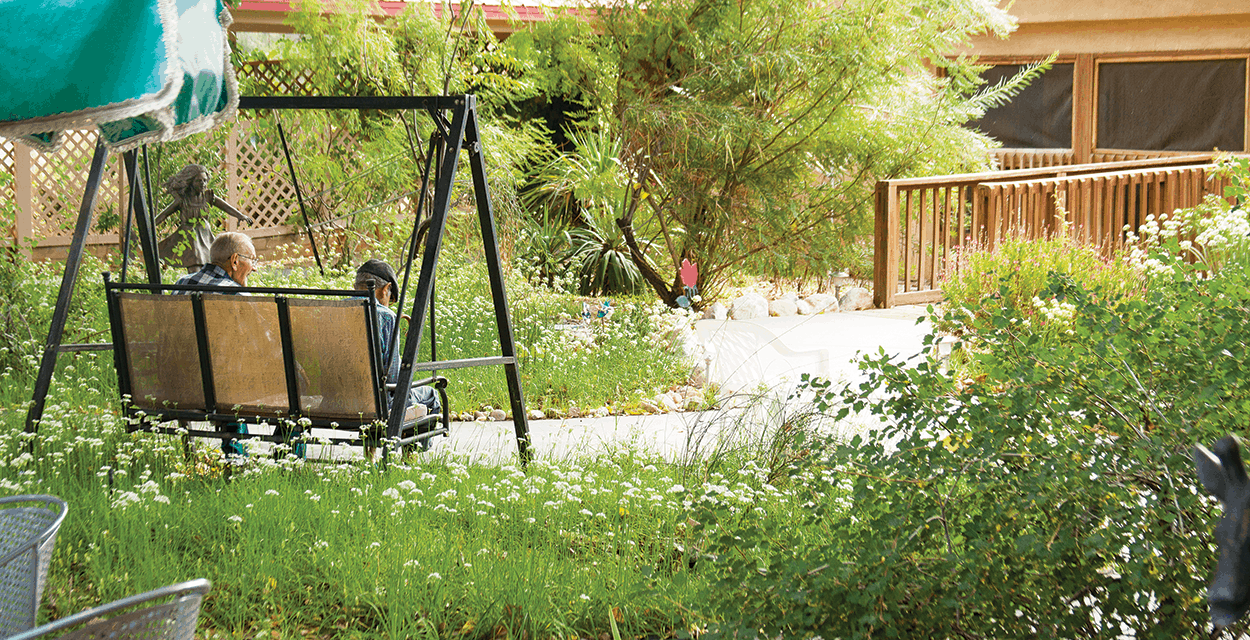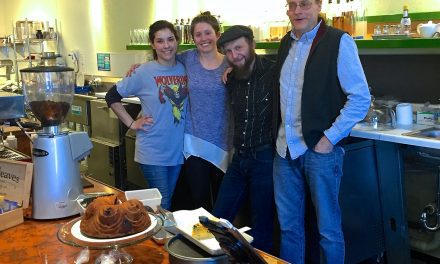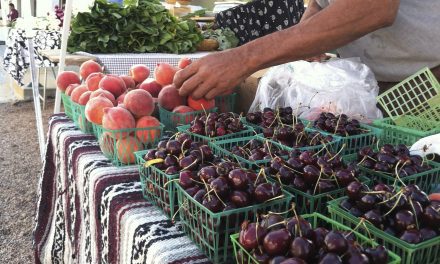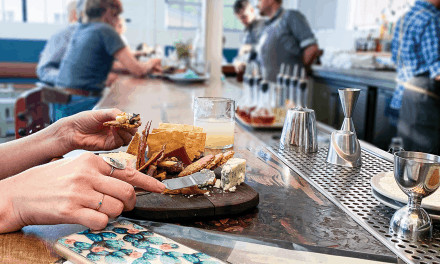The Center for Ageless Living Brings Fresh Ideas for Elder Care
By Nora Hickey · Photos by Stephanie Cameron

A butterfly the size of an outstretched hand, light yellow and marked with brown, moves in and out of red roses at the end of their time—spent blooms still perfuming the air. To the east, through a rowdy arch of prolific bamboo, sits a bistro that serves up meals using vegetables grown in nearby organic gardens. A close walk from that is a spa, complete with pool, hot tub, medical marijuana dispensary, and rooms full of soothing music and scent.
This oasis isn’t the latest day spa du jour to grace our state. It is instead a unique home for the elderly, replete with offerings not typically associated with the clients it seeks to serve, who are largely from lower-income, rural homes from the surrounding area. Nestled near Los Lunas, twenty-three miles south of Albuquerque, sits the Center for Ageless Living. Since founder Suzette Lindemuth opened the doors in 1990 with her distinctive vision of care, the center has become a source of community for a population that can often feel isolated. The forty-five residents are seniors in need of varying degrees of care, ranging from independent living, enhanced monitoring and assistance, to full twenty-four-hour attention.
The scene at the Center for Ageless Living is one that is expansive yet cocooned by beautiful old cottonwood trees, with a campus that unfolds over six acres next to a flowing acequia. It boasts many amenities for its residents, and also offers its services to everyone in the communities that surround the lush property. “We have people from Valencia and Albuquerque who come here for the spa, the salon, our wellness center, the Green House Bistro, and our park for music theater and performances,” Lindemuth explains. “We’re very fortunate we have this community around aging well and reducing the isolation around aging.”
With growing older comes an increased potential for unhealthy (and unpleasant) eating. This can be related to the food itself (a lack of nutrient-rich foods), the costs (seniors are increasingly unable to afford and access quality food), and basic difficulties surrounding shopping and preparing meals independently. On top of these issues, recent research suggests that our general population is increasingly eating alone more often, which can correlate with loneliness and depression, especially for seniors, as well as increased risk for heart disease and diabetes.
Lindemuth witnessed the effects of senior seclusion as a recreational therapist in the 1980s, when her vision for the center began to take shape. “I was working a lot with seniors, who were suffering from falls and memory loss, and I saw how there weren’t many choices for care,” she explains. “I have pretty strong compassion about people’s choices—how choices can impact the quality of lives.” In looking to expand options for seniors, Lindemuth became interested in community-based alternatives to the standard (and often highly regimented) clinical-style nursing home.
The Center for Ageless Living stands out distinctly in the history of elder care in the United States—one full of changes in regulations, culture, and population. The question of how to best care for elders demands new answers as society evolves, and there are few simple solutions. Since the 1960s, when the then-new model of nursing homes exploded, elder care has witnessed a number of evolutions—the introduction of hospice, the popularity of assisted living institutions that allow for more freedom, and now a post-retirement population numbering in the seventy millions. Among all these changes, an unfortunate theme has stayed consistent—one of neglect and lack of compassion. Warranted or not, the reputation of elder care has not been helped by reports of subpar facilities and abuse. The Center for Ageless Living is among a growing number of places that actively work against this damaging stereotype.
For Lindemuth, to minimize isolation one must cultivate community, and she has nurtured a natural path toward this through gardening and food. “I’ve always felt that when people have a good meal, everyone’s happy, and seniors are just like everybody else—a good meal makes their day special,” she says. “In these [elder care facilities] mealtime is a critical part of the day-to-day function of lives.” Lindemuth points to the act of eating as an antidote to the loneliness that many seniors experience as they age. “One of the things we know is that isolation is such a huge issue, and with that, mealtime can become tedious and not enjoyable. Eating is a social fiber, and the table can be a place where we come to make community, as Alice Waters says,” Lindemuth notes.
A main focus of the center is on the positive possibilities of mealtime. At the center, residents can help with any part of the food service, from setup to cooking to cleaning. As Lindemuth walks among the family style tables that are a centerpiece of the community kitchen and dining room, she greets residents and caretakers, each of whom she knows by name, working on hair or enjoying a cup of tea. “It’s a very communal kind of setup.”
Another notorious aspect of elder nutrition that Lindemuth is determined to revolutionize is the bland, overcooked mush that we tend to associate with getting older. At the center, residents benefit from onsite organic gardens and a culinary team dedicated to making mealtime delicious and enjoyable. The grounds hold 372 different plants and the edible ones include almond, quince, cabbages, chards, tomatoes, beets, melons, and more. There is a “fabulous baker,” Lindemuth tells me, who creates pies and cakes to go along with the changing Green House Bistro menu, which outside diners and residents alike can enjoy. On my recent trip, the bistro menu offered a variety of sandwiches and an impressive number of pasta and salads, which feature the compound’s own greens.
In the welcoming bistro, a mouthwatering coconut lime cake beckons in a glass display case and a chalked sign implores diners to “Support Your Local Farm!” Over a plate of Tuscan Golden Cheese Ravioli and the salad du jour (the spicy and fragrant mesclun harvested that day), head chef Keiten Johnson explains how working with the fresh produce from the gardens affects his culinary creations: “I often don’t know what’s an option until the gardener comes in with the produce. Last week, we were getting a lot of baby romaine, so I was doing braised romaine. Another time, we had lots of turnips, so I made a turnip soup. We try to incorporate freshness into each meal, and be as creative as possible, whether it’s for a resident or bistro diner.”

Lindemuth and Johnson both note that the residents are sometimes hesitant to try new foods, but that with a little thoughtfulness, they can expand their comfort zone. “When we try to introduce new things—like a couple of years ago we did couscous—it’s hard for them to embrace it because they don’t know what it is. So, we do an educational part—talk about where it’s from—and it’s that part that makes food fun. It’s through experiencing new spices, new tastes that we keep interested in life, so we try really hard to introduce new flavors,” Lindemuth says. And residents at the center benefit from the nourishing and novel food. “We do have a much higher length of stay than the industry overall, and I think if the residents have good food, they are happier.”
The gardens offer more than fresh, tasty provisions; the many natural areas on the campus provide opportunities for residents to get their hands dirty. Lindemuth realized her communal gardening dream when she found enough space. “I was fortunate to buy land around this facility,” she explains, “I was able to expand and really incorporate an organic garden and places where we could keep growing.” She points to the ways in which gardening facilitates cooperation and interaction as a distinctive benefit for residents. “Community gardens are all about socialization. And people, particularly the women, love to come together and plant and garden and tell stories. Physically it gets more challenging but the social aspect remains pretty strong.”
For one resident, eighty-four-year-old Alda, working with plants has become a happy pastime, a time to “play in the dirt,” she says from her room. Behind her on a windowsill, herbs in terracotta pots light up green, illuminated by the sun. Alda was an avid gardener at her home in Albuquerque and brought her skills to the center, quickly becoming a regular in the dirt. She recalls a recent project, when residents grew herbs from seeds in individual pots to give away to visitors over Earth Day weekend. “The basil started from seed and we took the tiny seedlings and it was wonderful when they came out as well as they did—they’re so tiny, you don’t know whether you’re getting them in the pot or if it’s the right spot!” she recalls. She also laughingly notes that none of her clothes fit her anymore. “I’ve got to get some new outfits soon, because of the three meals a day here.”
The Center for Ageless Living isn’t the only organization in New Mexico with innovative solutions for assisting elders. Since 1992, Kitchen Angels in Santa Fe has prepared and delivered home-cooked, healthy meals to those who are homebound and don’t qualify for other meal delivery services. “They are isolated people, so part of our service is that our volunteers are encouraged to visit to alleviate some of that loneliness associated with chronic illness,” explains Tony McCarty, executive director. “You add chronic illness to aging and [for our clients] making a meal just becomes an enormous task, so we provide a day’s worth of food as well as attention and companionship.” McCarty sees food as the ideal way to assist: “I think food is the most powerful way to build community. Sitting down at the table is both intimate and necessary.” Many of the relationships that began under the wings of the Kitchen Angels have taken flight through lifelong friendships and longstanding invitations to holiday gatherings. “It’s all about building community,” McCarty says.
Other spaces in the state offer older adults opportunities for community and food. The Barelas Senior Center in Albuquerque has space and opportunities for growing produce in their El Camino Real Garden. Increasingly, privately owned facilities are focusing on improving food quality and sourcing, and incorporating gardens for residents to take part in. Lindemuth notes, “As president of the Assisted Living Services organization for many, many years, I advocated for everybody, no matter where you were, to at least put in an herb garden. There are so many benefits from fresh herbs.”
“Everything we have done is to try and make a place where everyone can come—families, community, residents—and access good food and aging services,” Lindemuth notes. As the sun filters through the plum and pear trees, residents meet in the courtyard, dining areas, and pool. It’s clear that Lindemuth’s efforts have borne fruit.
Center for Ageless Living
3216 Hwy 47, Los Lunas, 505-865-8813
nmagelessliving.com
Kitchen Angels
1222 Siler, Santa Fe, 505-471-7780
kitchenangels.org
Edible celebrates New Mexico's food culture, season by season. We believe that knowing where our food comes from is a powerful thing. With our high-quality, aesthetically pleasing and informative publication, we inspire readers to support and celebrate the growers, producers, chefs, beverage and food artisans, and other food professionals in our community.












